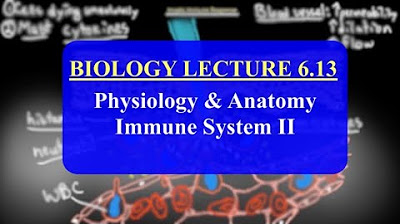Immunology | Immune System: Overview
Summary
TLDRThis educational video offers a comprehensive overview of the human immune system, focusing on both innate and adaptive immunity. It explains the innate response to bacterial invasion, including inflammation and the release of cytokines, and delves into the adaptive response involving T and B cells, antigen presentation, and the production of antibodies. The video also touches on the roles of phagocytes, complement proteins, interferons, and the distinction between humoral and cell-mediated immunity.
Takeaways
- 😀 The innate immune system responds to damage caused by pathogens, such as bacteria, by releasing endotoxins and inflammatory cytokines.
- 🔥 Inflammatory cytokines cause vasodilation, increased permeability, and pain, leading to the cardinal signs of inflammation: swelling, pain, heat, and redness.
- 🚀 Histamines and other chemicals can increase the production of cell adhesion molecules, enhancing the margination response and allowing cells to migrate to the site of injury.
- 🌡️ Inflammatory cytokines like IL-1 and TNF-alpha can cause fever, produce C-reactive protein, and trigger leukocytosis, indicating active inflammation.
- 💊 Phagocytes, such as neutrophils and macrophages, play a crucial role in the innate immune response by engulfing and breaking down bacteria through phagocytosis and lysosomal action.
- 🔄 The complement system, activated by pathogens, undergoes cascades that enhance inflammation, promote opsonization, and initiate bacterial lysis.
- 🌐 Interferons, produced in response to viral infections, activate nearby cells to produce antiviral peptides and enhance the immune response against viruses.
- 🔬 Toll-like receptors (TLRs) recognize different types of pathogens and trigger the production of signaling proteins, interferons, and pro-inflammatory cytokines.
- 🌀 Adaptive immunity involves the presentation of antigens by macrophages and dendritic cells to T cells, leading to activation and proliferation of T and B cells.
- 💉 Humoral immunity is characterized by the production of antibodies by B cells in response to antigens, leading to neutralization, precipitation, lysis, and agglutination reactions.
- 🛡️ Cell-mediated immunity involves cytotoxic T cells that target and kill cells infected by viruses or cancer, utilizing mechanisms like perforin and granzymes to induce cell death.
Q & A
What is the primary function of the innate immune system?
-The innate immune system acts as the first line of defense against pathogens, responding quickly to infections. It involves the release of inflammatory cytokines, which cause vasodilation, increased blood flow, heat, redness, and pain. It also triggers the production of cell adhesion molecules to enhance the margination response and the migration of immune cells to the site of injury.
What are the four cardinal signs of inflammation?
-The four cardinal signs of inflammation are swelling, pain, heat, and redness. These are caused by the action of inflammatory cytokines on smooth muscle cells and endothelial cells, leading to vasodilation, increased permeability, and fluid leakage.
How do inflammatory cytokines like leukan 1 and leukan 6 affect the body?
-Inflammatory cytokines like leukan 1 and leukan 6 can cause fever by acting on the hypothalamus, trigger the liver to produce C-reactive peptide (an indicator of active inflammation), and stimulate the bone marrow to produce more leukocytes through leukocytosis.
What is the role of phagocytes in the immune response?
-Phagocytes, such as neutrophils and macrophages, play a crucial role in the immune response by engulfing and destroying pathogens through a process called phagocytosis. They also expose antigens on their cell membrane with MHC II molecules, which helps in the activation of the adaptive immune response.
What is the purpose of the complement system in the immune response?
-The complement system enhances the immune response by undergoing specific cascades when activated. It helps in the lysis of bacteria through the membrane attack complex, enhances opsonization by C3b, and boosts the inflammatory response through C3a and C5a.
How do interferons contribute to the immune response?
-Interferons, such as alpha, beta, and gamma, are produced in response to viral infections. They activate nearby healthy cells to produce antiviral peptides, enhance the activity of natural killer cells, and stimulate macrophages to proliferate and increase their expression of class I and class II molecules.
What is the role of toll-like receptors (TLRs) in the immune system?
-Toll-like receptors (TLRs) are involved in recognizing different types of pathogens and initiating an immune response. They trigger the production of signaling proteins for chemotaxis, interferons, and pro-inflammatory cytokines, which enhance the inflammatory response and help eliminate foreign pathogens.
What is the process of antigen presentation in the adaptive immune system?
-In the adaptive immune system, antigen-presenting cells like macrophages and dendritic cells present antigens to T cells in the lymph nodes. This process involves the binding of antigens to MHC II molecules, which are then recognized by T cell receptors (TCRs) on T helper cells, leading to their activation.
What are the key differences between humoral immunity and cell-mediated immunity?
-Humoral immunity involves the production of antibodies by B cells in response to antigens, while cell-mediated immunity involves the action of cytotoxic T cells that target and kill cells infected by viruses or cancerous cells. Humoral immunity is primarily focused on neutralizing and eliminating extracellular pathogens, whereas cell-mediated immunity targets intracellular pathogens.
How do natural killer (NK) cells contribute to the immune response?
-Natural killer (NK) cells are part of the innate immune system and contribute to the immune response by killing virus-infected cells and cells with abnormal MHC I molecules. They recognize the absence or abnormality of MHC I molecules and release perforin and granzymes to destroy the target cells.
Outlines

This section is available to paid users only. Please upgrade to access this part.
Upgrade NowMindmap

This section is available to paid users only. Please upgrade to access this part.
Upgrade NowKeywords

This section is available to paid users only. Please upgrade to access this part.
Upgrade NowHighlights

This section is available to paid users only. Please upgrade to access this part.
Upgrade NowTranscripts

This section is available to paid users only. Please upgrade to access this part.
Upgrade NowBrowse More Related Video
5.0 / 5 (0 votes)





